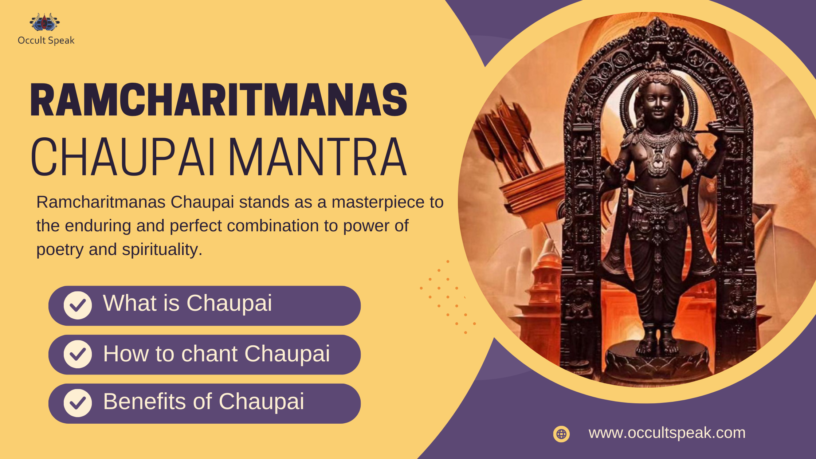Introduction to Ramcharitmanas Chaupai
The Ramcharitmanas Chaupai, an esteemed literary composition by the revered poet-saint Tulsidas, occupies a cherished place in the hearts of devotees and literary enthusiasts alike. This sacred text, rendered in the Awadhi dialect of Hindi, presents a profound interpretation of the epic Ramayana.
Among its captivating sections, the Chaupai verses stand as resplendent gems, embodying poetic brilliance and spiritual depth.
This article endeavors to delve into the essence of Ramcharitmanas Chaupai, examining its distinctive features, profound significance, and enduring influence.
Poetic Structure and Linguistic Mastery in Ramcharitmanas Chaupai
Ramcharitmanas Chaupai verses are composed in a distinct meter known as “Chaupai,” characterized by a unique arrangement of four lines, each containing 16 syllables.
This rhythmic pattern creates a melodious cadence that accentuates the emotional resonance of the verses. Tulsidas’ linguistic prowess is evident in his employment of vivid imagery, metaphors, and similes, evoking vivid mental imagery for the reader.

Profound Spiritual Symbolism in Ramcharitmanas Chaupai
Beyond their poetic beauty, the Chaupai verses are imbued with profound spiritual symbolism. Tulsidas skillfully weaves allegorical meanings into the narrative, unveiling deeper truths about the nature of reality, devotion, and the human condition.
Each verse serves as a window into the spiritual realm, inviting readers to contemplate the divine essence that pervades the universe.
Characterization and Evocation of Devotion in Ramcharitmanas Chaupai
The Chaupai verses bring to life the characters of the Ramayana with unparalleled depth and nuance. Tulsidas’ portrayal of Lord Rama, Sita, Lakshmana, and Hanuman is so vivid that they transcend mere literary figures, becoming embodiments of divine virtues.
Through his evocative storytelling, Tulsidas instills a profound sense of devotion and love for these revered figures in the readers.

Ethical and Moral Teachings in Ramcharitmanas Chaupai
Ramcharitmanas Chaupai verses serve as a rich source of ethical and moral teachings, offering timeless wisdom for everyday life.
Tulsidas addresses universal themes such as dharma, karma, and the importance of righteous conduct. Each verse contains valuable insights that guide readers toward leading virtuous and fulfilling lives.
Narrative Power and Cultural Influence through Ramcharitmanas Chaupai
The Chaupai verses of Ramcharitmanas have had a profound impact on Indian culture and society. Their narrative power has served as an inspiration for generations of artists, musicians, and writers, who have drawn upon Tulsidas’ words for their own creative expressions.
Ramcharitmanas Chaupai has become an integral part of religious ceremonies, festivals, and cultural gatherings, fostering a sense of unity and devotion among people from all walks of life.
Now, let us move to a few important Ramcharitmanas Chaupai Mantras which are extremely powerful in solving daily problems which arise in every grihastha jeevan.
How to Use Ramcharitmanas Chaupai as Mantra?
Since, Ramchaitmanas Chaupai is not only Sacred Textbook in Sanatan Dharma but it is a wonderful mantra granth to solve not only daily routine issues of life, but also it helps in removing obstacles from your life.
The Vedic Vidhan of reciting Ramcharitmanas Chaupai mantra is quite lengthy with an elaborate process.
( I will publish in my next blog / month.)
Here, I will say, you need to keep a wooden plank, give asana to Lord Rama ( place Ram Darbar Picture ) on Yellow or Kesari Asana.
Now, light Cow Ghee Diya and Chant 1 mala of Ganesha mantra-
Om Gam Ganapatye Namah
ॐ गं गणपतये नमः
Then recite Guru Mantra –
Om Namah Shivaya
ॐ नमः शिवाय
108 times and then Recite any one Mantra (108 times ) which helps you as per your need/requirement.

To remove obstacles / hurdles बाधाओं/बाधाओं को दूर करने के लिए-
Rajiv Nayan Dhare dhanu sayak, bhagat vipaati bhanjak sukhdayak
राजीव नयन धरे धनु सायक, भगत विपति भंजक सुखदायक II
To please Hanumanji (हनुमानजी को प्रसन्न करने के लिए)
Sumiri Pavansuth Pavan Naamu, Apne Vash kari Raakhe Naamu
सुमिरि पवनसुथ पवन नामु,अपने वश करि राखे नामु II
For Headache relief (सिरदर्द से राहत के लिए)
Hanuman Angad Ran Gaaje, Haak Sunat Rajnichar Bhaaje
हनुमान अंगद रण गाजे,हक सुनत रजनीचर भाजे II
To Find the Lost Object (खोई हुई वस्तु ढूंढने के लिए)
Gai Bahor Gariv Newagu, Saral Sawal Sahib Raghuraju
गै बहोर गरीब नेवाजू, सरल सबल साहेब रघुराजू II
For Wealth and Abundance (धन और प्रचुरता के लिए)
Atithi Pujya Priyatam Purarike,Kaam da Dhan Darida Dawarike I
Je Kaam Sampati Nana Vidhi Paavhi II
अतिथि पूज्य प्रियतम पुरारिके,काम दा धन दरिदा दवारिके मैं जे काम संपति नाना विधि पावहिं II
For Protection from Rivals/ enemies ( शत्रुता मिटाने और रक्षा हेतु )
Bayroo Na Karu Kahu Sun Koi, Ram Pratap Vishamta Khoi II
बायरू न करु कहु सुन कोई, राम प्रताप विषमता खोई द्वितीय II
For Son Birth ( पुत्र प्राप्ति हेतु )
Dani Shiromani krupanidhi nath,Kahauu Satibhau Chaahu Tumhi Samaan
Sut Prabhusan Kavan Durav , Prem Magan kaushalya Nishidin Jaat na Jaan
Sut Sneh Bus Mata Balcharita Kar Gaana
दानी शिरोमणि कृपानिधि नाथ, कहौउ सतिभौ चाहहु तुमहि समान II
सुत प्रभुसन कवन दुरव, प्रेम मगन कौशल्या निशिदिन जात न जान
सुत स्नेह बस माता बालचरित कर गाना II
To know Dark Secrets of Anyone ( गुप्त मनोरथ सिद्धि हेतु )
Sunahu Dev Sacharachar Swami Pranatpal Urr Antaryami More Manorath Jaanuh Nike, Bushu Sada Urpoor Savhike II
सुनहु देव सचराचार स्वामी प्रणतपाल उर अंतर्यामी मोरे मनोरथ जानुह नीके बशु सदा उरपूर सवहिके II
For removing Black Magic (काला जादू हटाने के लिए )
Mangal Bhavan Amangal Hari, Dravahu Sudasrath Ajir Bihari
मंगल भवन अमंगल हारी, द्रवहु सुदसरथ अजिर बिहारी II
For War and Welfare (युद्ध और कल्याण हेतु)
Kar Sarang saaji Kaati Bhaatha I Aridaal Dalan Chale Raghunatha II
कर सारंग साजी काति भाथा मैं अरिदल दलन चले रघुनाथा II
For Love and Attraction (प्रेम और आकर्षण हेतु )
Jehike Jehipar Satya Sanehu, Sou tehi Mile Na Kuch sandeshoo
जेहिके जेहिपर सत्य सनेहु, सौ तेहि मिले न कुछ संदेशु II
For Charm and Good Personal bonding ( वशीकरण व सम्मोहित करने हेतु)
Kartal Baan Dhanush Ati Sohaa I Dekhath Roop Charachar Moha II
करतल बाण धनुष अति सोहा मैं देखथ रूप चराचर मोहा II
For Controlling others (वशीकरण हेतु)
Jan Man Manju Mukul Mal Harani I Kiye Tilak Gun Gan Buskarani II
जन मन मंजु मुकुल मल हरणी मैं किये तिलक गुन गण बसकरणी II
For Removal Obstacles in Work
(कार्य सिद्धि हेतु )
Swayam Siddh Sab Kaam Nath I Mohi aadar Diyo Ash Vichar Yuvraj Tan
Pulkit HarSheet Kiyaoo II
स्वयं सिद्ध सब काम नाथ मैं मोहि आधार दियो ऐश विचार युवराज तन पुलकित हरशीत कियौ II
For Successful Journey (सफ़ल यात्रा हेतु)
Prabishi Nagar Kijee Sab Kaajaa I Hyday raakhi Koushalpur Raja II
प्रबीशि नगर कीजे सब काजा I ह्यदय राखी कौशलपुर राजा II

Conclusion:
Ramcharitmanas Chaupai stands as a masterpiece to the enduring and perfect combination to power of poetry and spirituality.
Goswami Tulsidas’ ji ‘s masterful use of language, his profound insights into the human condition, and his unwavering devotion to Lord Rama have elevated these verses to the status of timeless classics.
Whether recited in temples, studied in schools, or simply read for personal reflection, Ramcharitmanas Chaupai continues to inspire, uplift, and guide countless souls on their spiritual journeys.
I hope, my small effort on writing article on Ramcharitamanas Chaupai Mantra will brings health wealth and happiness to my readers.
Jai Sri Ram!




Leave a Reply